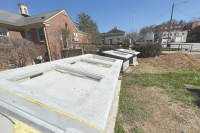Tragedy at Frank Lloyd Wright’s house
 In this story, I am God. — Frank Lloyd Wright
In this story, I am God. — Frank Lloyd Wright
The title of this nonfiction work, Death in a Prairie House, is misleading since it suggests that it is the latest offering from a crime fiction writer. While the title is appropriate, the actual subject discussed by William R. Drennan is much more. It is one of the most provocative mysteries in the history of American crime: the murders of seven people on August 5, 1914, in Frank Lloyd Wright’s famed “love nest, “Taliesin” in Spring Green, Wisconsin.
The name, Frank Lloyd Wright, the famed architect evokes images of startling design: Falling Waters, built in 1935, remains one of the most famous structures in America; the Imperial Hotel in Tokyo, and the Midway Gardens in Chicago — all attest to Wright’s genius.
However, there are other reasons for Wright’s reputation as one of the most well known men in the world. His lifestyle shocked his neighbors. Wright gathered a kind of “artist colony” around him and his notorious parties and heedless disregard for public opinion made him front-page news. Wright was frequently condemned from the pulpit (Wright abandoned his Baptist Church and became a Unitarian) and often voiced his opinion that marriage was an obsolete concept. He frequently applauded the principles of “feminism” and spoke in defense of “free love.”
At the turn of the century, the general public knew Wright through his publicized personal life. He had abandoned his wife and six children to run away with his neighbor’s wife, Mamah (pronounced “may-muh” Cheney.
It turns out that Wright and Mamah have much in common. Mamah has acquired a bit of attention for heir translations of the works of Ellen Key, a Swedish feminist, and Wright decides that Key’s advice regarding marriage is “realistic.” He and Mamah decided get divorces and live together until such time as they choose make a commitment to each other for the future.
Related Items
Both divorces prove to difficult and the two lovers found themselves frustrated due to legal delays. However, Wright’s solution is that he will construct a specially designed place for Mamah that he chooses to call Taliesin in honor of an ancient Welsh bard. Wright tells his friends that this new home is a hegira, or safe place, but the public quickly names it a “love nest” where Wright can live with Maymah without benefit of marriage.
During the next two years, Taliesin becomes a gathering place for the wealthy and famous. Although designed to be a self-supporting farm, it functions as an estate complete with a staff ... including a kitchen manager and his wife. There are accommodations for visitors and cultural entertainment. Poets, actors and noted writers come and go.
Julian and Gertrude Carlton (allegedly married) were fairly new employees at Taliesin. They said they were from Chicago, both African-American and had been employed the previous June by Wright. They were also the only black employees at Taliesin and for miles around. Julian claimed that he was from Barbados; however, his death certificate gives his birth place as Alabama. Ironically, Wright considered Julian to be an excellent cook and often praised him, noting that Julian had come with excellent recommendations from John Vogelsang Jr., a prosperous Chicago caterer and restauranteur.
The massacre at Taliesin on August 5, 1914, occurred around noon. Guests had just been seated for lunch. Later, when the series of events were reconstructed, the police concluded that Julian Carlton, dressed in his white servant’s jacket, murdered seven people with a shingling hatchet, striking with both the hatchet’s blade and hammer. The first victim was Mamah, who has struck from behind as she sat at a table, her skull shattered. Afterwards, Julian killed Mamah’s son, John. Martha, Mamah’s daughter, witnessed the murders and ran screaming from the room into the courtyard when Julian caught her and killed her and turned immediately to the workman’s dining room next to the kitchen.
Julian returned to the kitchen and picked up a pot of soup, which he carried to the dining hall where he served the waiting men. While they were eating, Julian locked the door from the outside. Then, he emptied several cans of gasoline under the locked door; after it ran through the small dining room, Julian lit his pipe and then dropped the match into the gasoline. The room was immediately turned into an inferno. The trapped men rose as flaming torches and began to crash into the locked door. Julian waited patiently on the other side, clutching his bloody hatchet and puffing his pipe.
Several workers managed to crash through windows and fall outside. One of them, Emil Brodelle, seemed to be singled out by Julian as someone who must not be allowed to escape. When Brodelle, his clothes on fire, attempted to run, Julian killed him with a single blow.
Much of this horror was witnessed by Herbert Fritz, a worker who crashed through a window and although badly burned, survived. He witnessed the murder of Brodelle and saw Julian return to the house where he murdered three more people and, carrying containers of gasoline, set fire to the house and poured additional fuel on the corpse of Mamah and her son.
Then he vanished. He was found the next day inside Taliesin’s furnace which was lined with asbestos. He intended to survive the fire. In jail, he attempted suicide by swallowing acid. The attempt failed, but damaged his throat, making it nearly impossible to speak. He died shortly afterwards, leaving some unanswered questions.
This book contains additional information regarding this tragedy. However, it fails to answer the question that that has haunted historians and Wright biographers since. Why did he do it? Why did Julian Carlton descend like an avenging angel on Taliesin?
The easy answer is that he was insane. Yes, quite likely, but we need a better answer. Did he murder these people who were, in the eyes of God (or the people who disapproved of Frank Lloyd Wright’s sexual misconduct) sinners who deserved their fate? One theory is that he did it because both he and his wife had been fired and they felt that they had been mistreated. Another theory holds that he was a black man surrounded by wealthy white people, and his isolation turned him into a psychopath.
One thing is certain. As grotesque as the incident was, it did not hinder Frank Lloyd Wright from fulfilling his wishes. He rebuilt Taliesin, married again and went on to build an astonishing number of structures which, in Wright’s mind, resembled “frozen music.” His autobiography notes that he considered suicide after Mamaw’s death, but was deterred by his unfulfilled dreams.
Note: Another troublesome question, but one that is easily answered. Where was Wright on the night of the massacre? He was in Chicago completing plans for the Midway Gardens project — possibly his greatest success.









